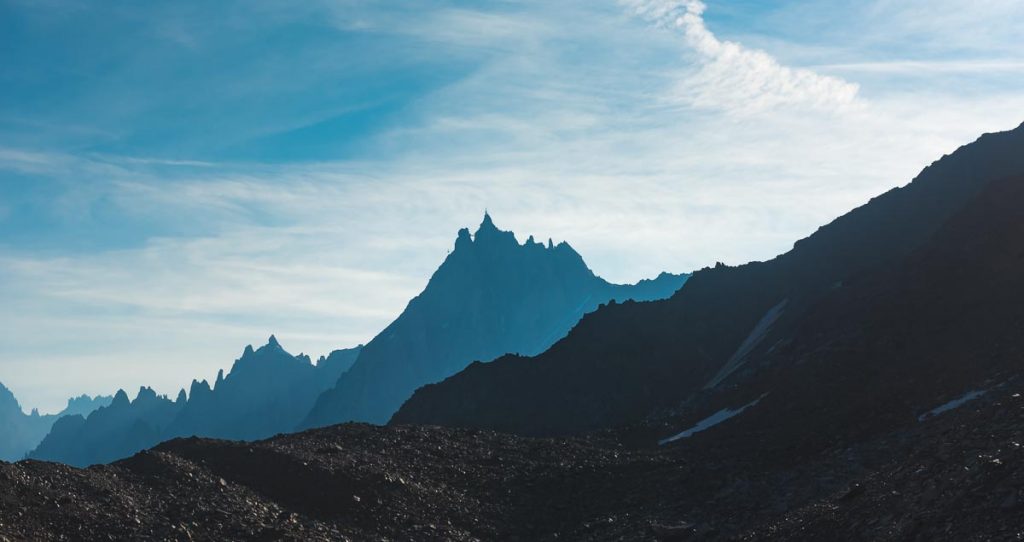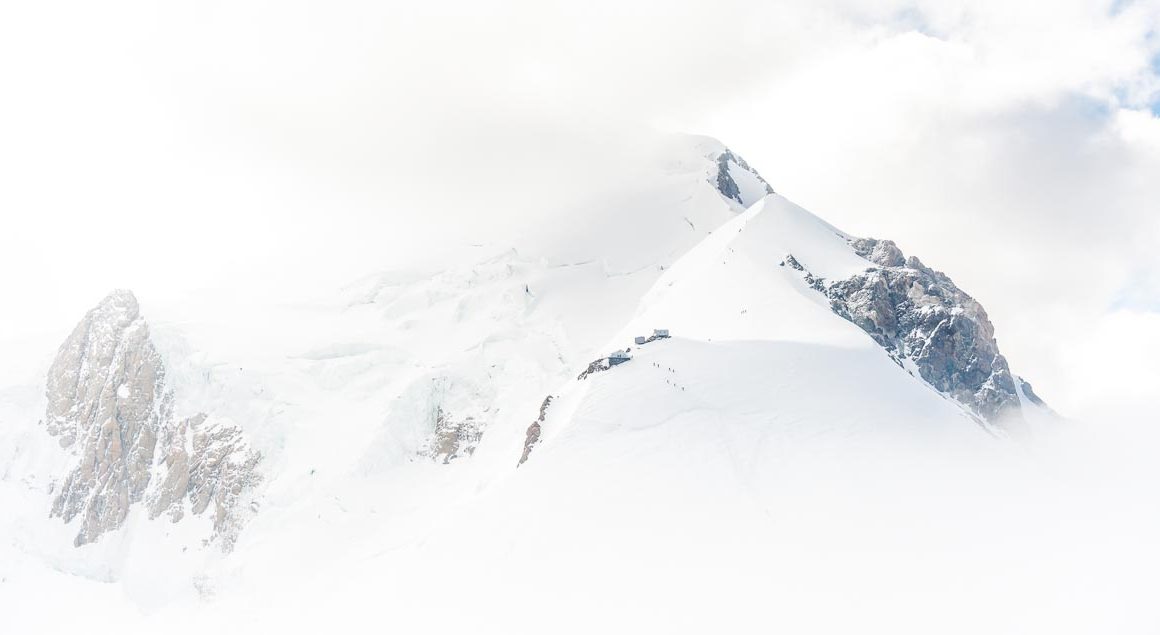Why I climbed Mont Blanc
If you’d told me three years earlier that I’d be climbing Western Europe’s highest mountain, I’d simply have laughed. Yet this summer I summited Mont Blanc, which begs the question: what drives people to climb?
When I got back home after climbing Mont Blanc, I found it hard to recount my experiences in a coherent and compelling manner. I tried a chronological story and just skipping to the grand finale, but both options felt slightly unsatisfying. It seems to be a bit of a fashionable thing in self improvement books to focus on why. I decided to jump the band wagon and center my thoughts for this post around that very concept. Why did I climb this mountain?
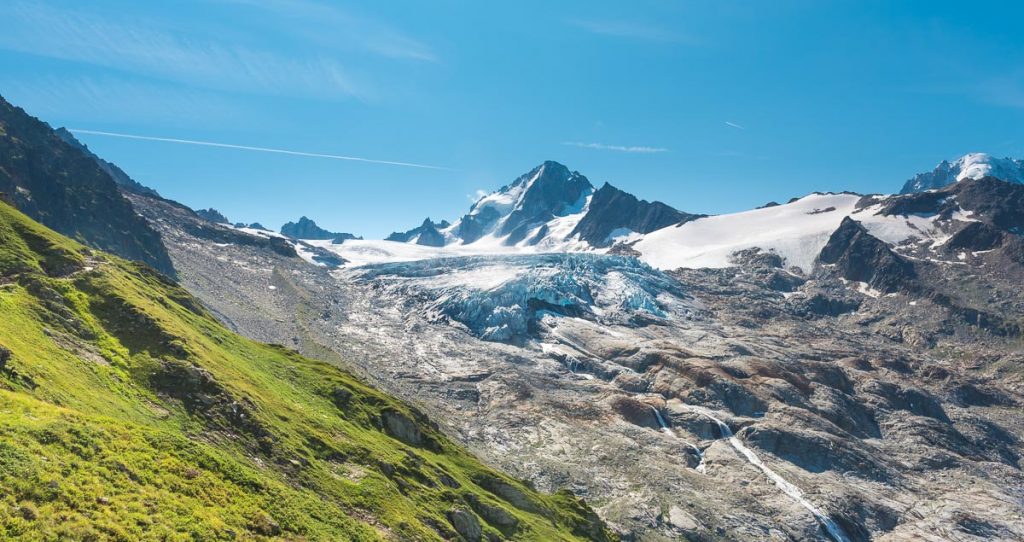
Putting the question like this, one may think that it was a very rational thing I’d thought through thoroughly. Nothing could be further from the truth though. While driving to Mont Blanc with my fellow climbers, we discussed each of our respective motives for the climb. It was only at that moment that I started to really think about my motivation. I discovered that it wasn’t the mountain’s height or reputation that drove me to France. In the end, the manner in which I summited worked out perfectly with this motivation. But I digress, it could be best to first describe what an ascent of this 4810m high peak entails.
Mont Blanc and Chamonix
Mont Blanc is one of the highest peaks in all of Europe. It is quite accessible and is climbed rather often. Beautifully situated at the mountain’s foot is the mountain village of Chamonix. The photo below provides a great view of the relationship between the mountain and the village. Arguably the easiest way to climb the peak is the normal route or Goûter route. This route starts at the other side of the mountain ridge on the right of the photo, just above Chamonix. From there, climbers follow a steep rocky slope until reaching the white ridge furthest on the right in the photo below. From this point onward, the route pretty much follows the outline of the mountain in this photo, going left. This includes climbing the big hump (Dôme du Goûter) and finally climbing all the way to the summit.
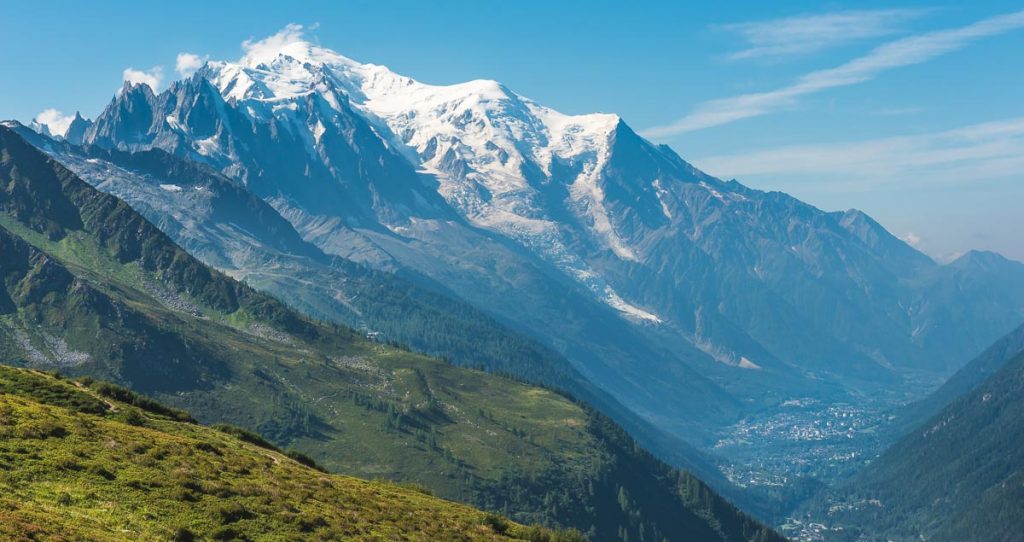
Acclimatisation and preparation for climbing Mont Blanc
Before even setting one foot on the actual mountain though, acclimatisation is a necessity. In the guided tour I participated in (organised by Mountain Network, highly recommended), our guides first took us for a three day tour of the nearby Aiguille du Tour. At 3540m high, climbing this peak allowed us to get used to the higher altitude without being too strenuous. My fellow climbers and me actually opted to arrive two days earlier, to take a casual hike and take in the scenery. With clear blue skies, the view we had of our penultimate goal was spectacular.
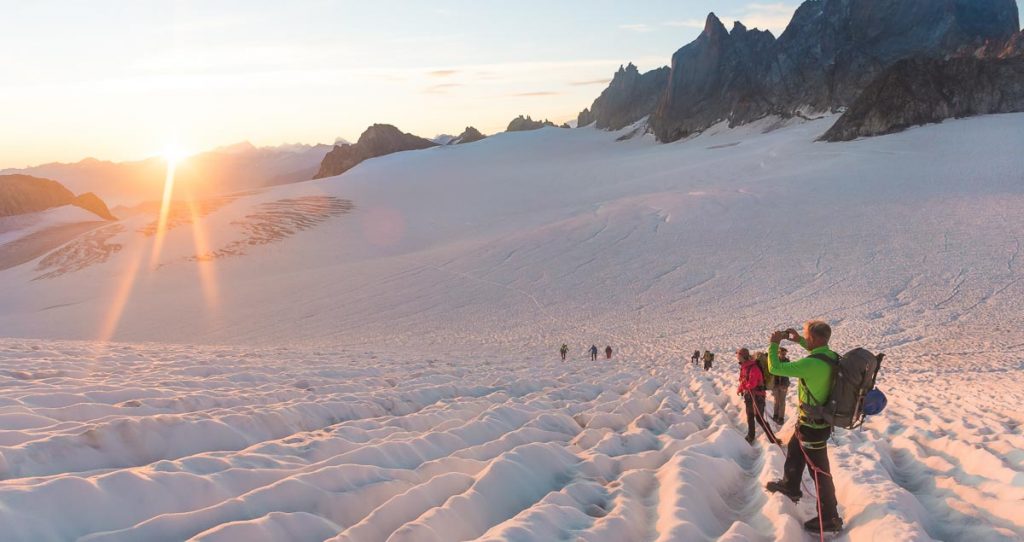
Ice climbing on the glacier du Tour
Part of our three day tour around the Aiguille du Tour included some basic practice on the glacier. I’d walked on crampons before, but had a rather hard time getting used to walking on steep icy slopes again. After some special attention from our guide Master Guy though, I got back into the groove. At the end of the week I realised I was able to really haul ass on crampons on steep terrain. This just underlined how total immersion can help you learn skills extremely fast.

After we’d spent some time practicing, it was time for play. My team tried which walls we could scale using our newfound skills with crampons and ice axes. If it weren’t for our guides, some of our team would probably have found their way to severely overhanging terrain.
Summiting Aiguille du Tour
The climb to the summit of Aiguille du Tour was actually a bit more involved and technical than climbing Mont Blanc turned out to be. Though significantly lower, it involved a steep patch of narrow and unstable ice, and scrambling in exposed rocky terrain. I can hardly thank younger me enough for picking up bouldering at some point while in university. These rock climbing skills come in extremely useful in alpinism time and time again.
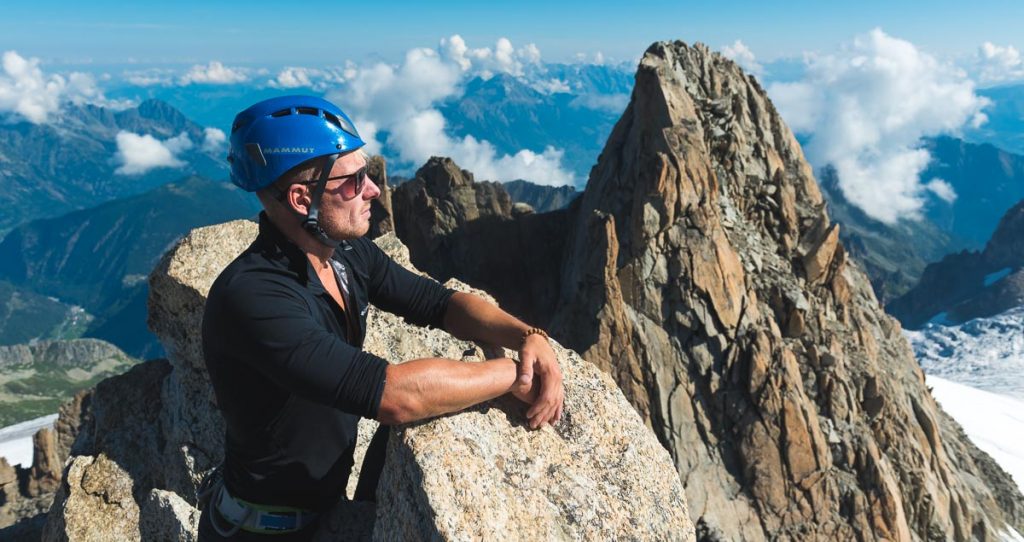

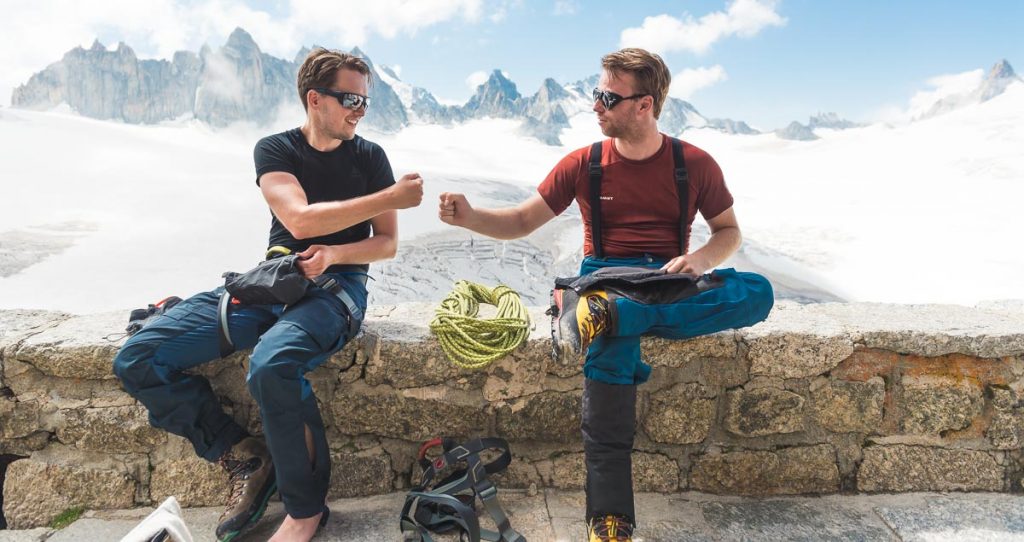
Quite possibly the thing I remember best from this climb is the magnificent rösti I had at the Swiss Trient hut afterwards. Rösti are thin pieces of fried potato, mixed with some onion and herbs. Mine had three baked eggs on top, providing the necessary protein and carbs for recovery.
To go or not to go
Conditions on Mont Blanc had been sub optimal ever since we’d arrived in Chamonix. Basically, the weather had been far too hot and dry. This dramatically increased the risk of rockfall. It also meant the weather was unstable, with potential thunderstorms in the afternoons.
When we got back down in the valley after descending from Aiguille du Tour, our guide Jehan Roland has some news for us. He’d taken a long hard look at the weather forecast and the latest report on the conditions up on Mont Blanc, and the decision was made to give it a shot. Me and my fellow climbers had been in a bit doubt as to whether we could even try for the summit, so you can imagine this news was met with some big smiles.
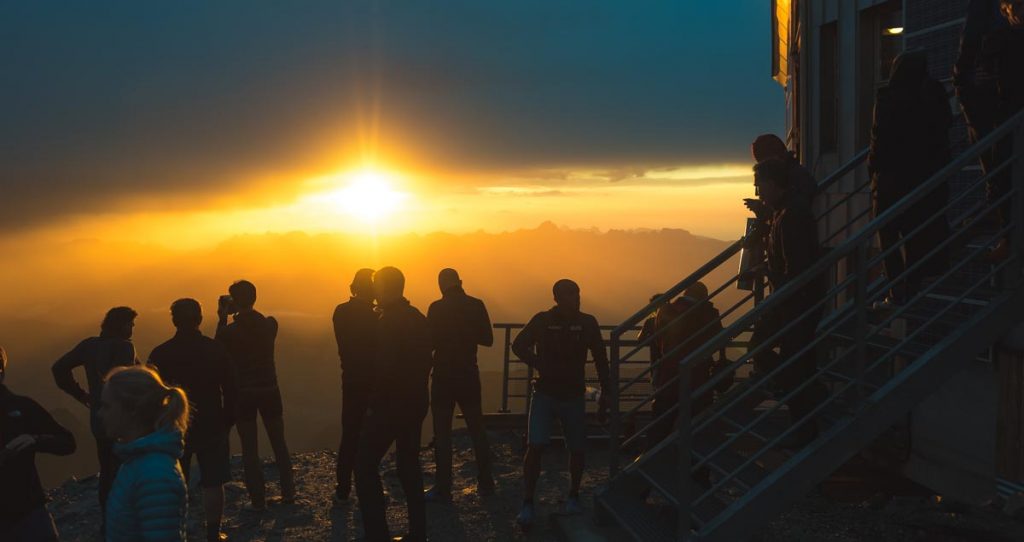
Hiking to the Tête Rousse hut
Any climb of Mont Blanc via the normal route starts with a train ride to just above the tree line. From there, a 1-2 hour hike through rocky terrain on rudimentary paths take you up to the Tête Rousse hut. Just before the hut though, you have to cross a tiny glacier. We got to the glacier somewhere at the start of the afternoon, and the weather was warm. I got a tiny bit unfocused and managed to step on an unstable part of the snow cover. My foot punched right through and was soaked in the stream of melting water that flowed beneath the surface.
I’d brought an extra pair of socks, but the soaked boot had me quite worried. I spent the better part of the rest of the day trying to dry it up, stuffing in toilet paper and exposing it to the sun as much as I could. Most of us opted to lie down for a bit and rest.
Sunset at the Tête Rousse hut
After dinner, we were treated to yet another insane sunset, with the sun piercing through the cloud cover. It was quite amusing to at first be the only ones enjoying this spectacle outside of the hut, only to be joined by two dozen or so fellow climbers before too long.
One of these climbers approached me and my teammates, asking whether we’d be going up to the summit the next day. Turned out their guides had advised their group not to go up, but left the decision in their hands. This group of Belgian climbers was rather worked up about their whole situation. At some point they seemed to almost be fighting with their guides. It’s alarming to see how really having a strong desire to accomplish something can bring out the worst in climbers.
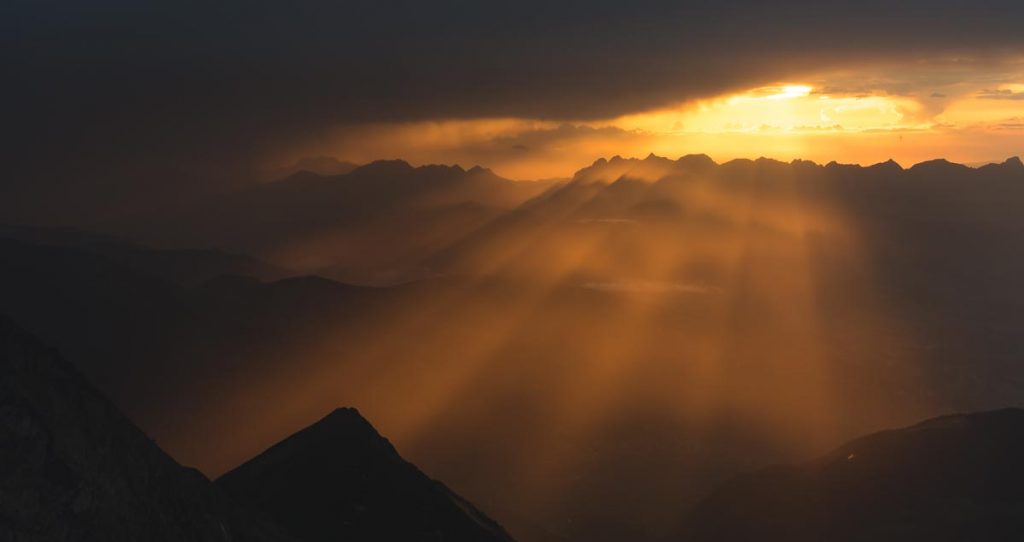
The dreaded couloir
The next morning started off with the most dangerous section of the entire climb: the dreaded Grand Couloir. From the Tete Rousse hut, climbers quickly stumble upon this steep gulley littered with loose rocks. The size of the rocks ranges from a tiny pebble to blocks as big as a fridge. As the weather gets warmer, the snow that glues the rocks to the ground melts, and rocks start falling down. The gulley essentially functions as a massive slide, launching rocks down the mountain at alarming velocities.
The walk across the gulley is only 100 meters or so and can be done in well under a minute. Still, the consequences of being hit by even a small rock are grave. Several people die on this tiny part of the mountain every year. Some of them aren’t even killed by rocks but are too consumed with watching for them, not minding their feet and falling down the steep slope.
The first video below shows some climbers quickly walking across the couloir, with stones flying down moments after. The second video shows how bad the rockfall can get – pay attention to the massive block at the start of the video.
My group made it across the gulley safely, by crossing it early in the morning. Next came a 600 vertical meter scramble up rocky terrain, which felt like bouldering. I was able to save quite a bit of energy here. We then finally made our way into the snow, up on the Goûter ridge. We rested a bit at the hut and filled our stomachs with tea and calories.
A palace in the clouds
Having left behind all but the bare essentials for our final climb, I clipped in to the rope with my guide and my teammate. From this point onward, the climbing wasn’t technical or even that dangerous. The difficulty of this part is in endurance and persistence rather than skill. Basically it feels like walking up a ski slope that lasts forever. What’s more, the air is getting quite a bit thinner now, and the altitude leaves its mark. Though the weather was good for now, our guide warned us that bad weather would come in the afternoon. He set us a deadline: at 12 in the afternoon, we’d be turning back – whether we’d made it to the summit or not.
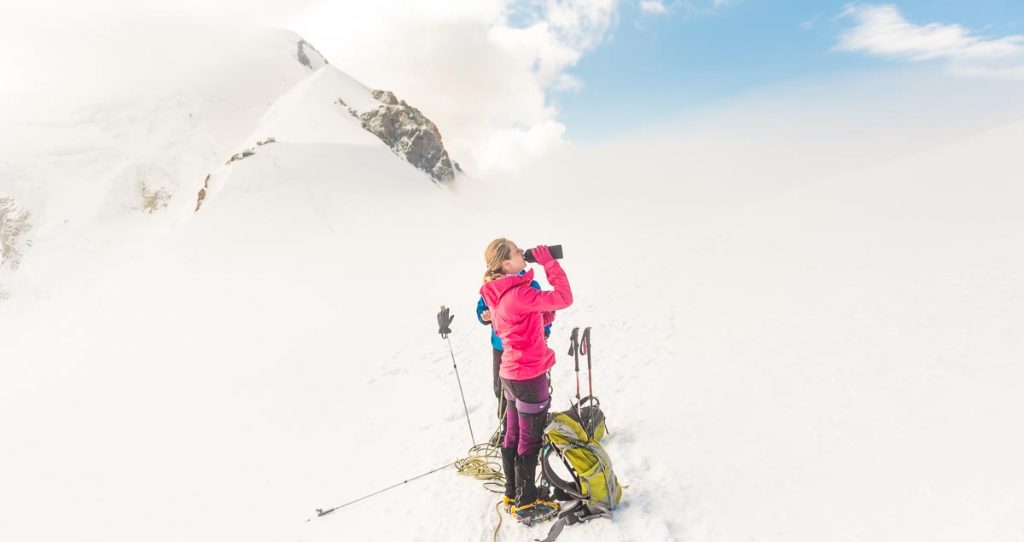
One moment I won’t easily forget is reaching the top of the Dome du Goûter. From here, you get to see the actual summit of Mont Blanc for the first time. This view was nothing short of intimidating. The summit was shrouded in clouds, reminding me of how enormous palaces look in cartoons. Helicopters circled the summit, underlining that this was no place for games. Accidents happen here, and can easily have grave consequences.
One down on Mont Blanc
It was right around this time that my teammate started having a hard time. The climb had been very involved for her, and she was probably worried about the 12 PM deadline our guide had set us. I have to admit that this view of the summit looked like it would take forever. After climbing up a steep slope to the Vallot emergency shelter (visible in the photo below), my teammate indicated she couldn’t go on any further.

We happened to cross paths with a mountain guide just descending, who was happy to have Lotte join him going down. This turned out to be my saving. If we hadn’t run into the guide, I would have had to go down as well. I’m extremely thankful of my teammate for how she handled the situation. I’d hardly have blamed her if she’d have wanted to try for the summit anyway, with the weather window possibly spoiling our attempt.
Race to the top
I was now alone with my guide. This meant I got to set the pace, and I immediately let Jehan Roland know I wanted to push hard. I’d spent months training, all for this one morning. I felt very grateful to get the chance to test myself. For the better part of the week, it had looked like we may not even be trying for the summit.
The climb from the Vallot hut to the summit normally takes about 2 hours. I really felt the benefits of my training at this point. The climb involved steep parts that made my legs pumped and my heart rate spike. As soon as the slope got a bit more gentle though, I quickly recovered even while still pushing hard, ready to take on the next steep part. In the end, we made it to the summit in just over an hour. My guide described it as magic and something he hadn’t done with a client before, and on Strava it earned me the fastest time for this segment in 2018 and 3rd overal. Of course not all climbers bother to track their ascent through this app.
This race had one drawback: it meant I had virtually zero opportunity to shoot photos. I felt that physically challenging myself was more important at this occasion though. Other opportunities to shoot photos in alpine environments will come.
For more alpine adventures check out this album.
From superficial motives to a nobler motivation
This long winded report brings me back to answering my question. Why did I want to climb this mountain? I feel that the thing that initially made me sign up for it, was superficial. It’s Europe’s most famous mountain and one of its highest as well. While training though, my perspective shifted. I wanted to test myself. To see whether I could dedicate to training for a single goal for months on end.
But in that car on the way to Chamonix, I realised there may be a nobler motive. Even for a relatively accessible peak like Mont Blanc, so many factors that determine whether you make it to the summit are uncontrollable. The weather, snow and rock conditions, your teammate’s condition and stupid little accidents like soaking your mountain boot in an ice cold stream are all more or less out of your hands. You can’t simply train hard for three months and then force yourself to the summit, with no regard for the circumstances. Ultimately, through climbing this mountain I wanted to test myself in a mental manner.
Finding my why
It was about pushing on when things got hard, but it was about more than that. It was about coming to terms with whatever happened, especially if what happened was out of my hands. One can’t control the weather, snow conditions or whether a team mate feels good enough to push on. It’s only possible to control your how these things make you feel. Now I’m not quite the first to come up with this, most notably Viktor Frankl used this mentality to endure a nazi concentration camp, which is arguably ‘quite a bit’ rougher than dealing with not making it to the summit of Mont Blanc.
I think in the end this trip provided me just what I was looking for. It presented me with the challenge of not getting anxious about the weather, conditions on the mountain and possibly having to turn back around because of the weather window. Then, as a sort of treat, I got the opportunity to participate in a sort of grand finale with a super well defined deadline. I got to challenge myself both mentally and physically, and feel excited to get back to the Alps to climb some gorgeous peaks, that are perhaps slightly less crowded than the White Mountain.
